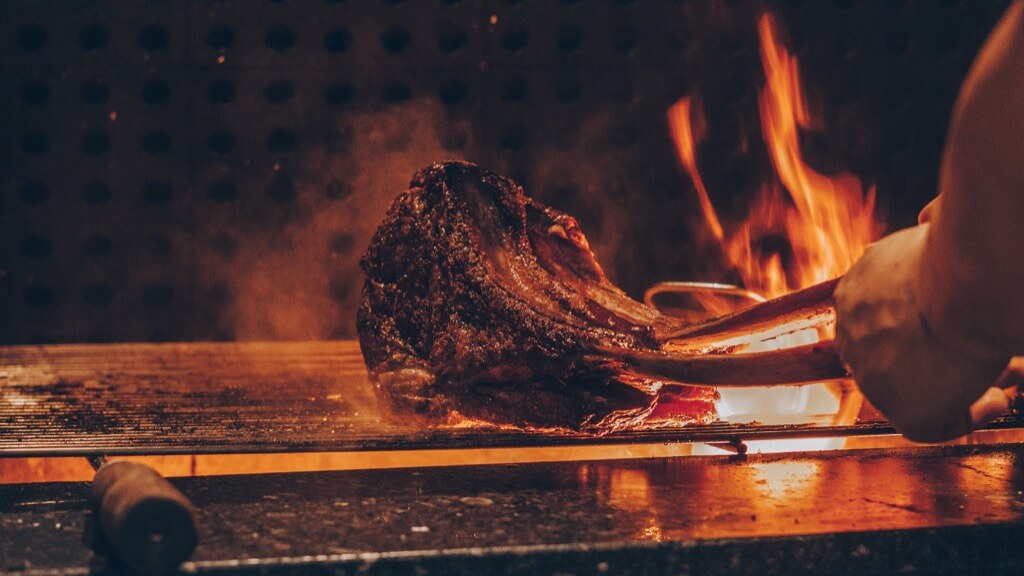Have you ever wondered why red meat browns on your grill turn into an irresistible brown delight? The answer is within the meat’s cells, specifically in myoglobin protein. Contrary to common belief, the redness in raw red meat isn’t due to blood but rather to this crucial protein. Myoglobin is akin to hemoglobin, the oxygen-transporting protein in red blood cells. In muscle cells, myoglobin stores oxygen, a vital element muscles need for energy, especially during continuous use.
Let’s look at how myoglobin, this oxygen-storing artist, paints our meat in different colors. When raw, meat flaunts a vibrant red or pink hue thanks to oxygen-rich myoglobin. With iron in the +2 oxidation state, this form gives raw meat its characteristic color.
Now, let’s turn up the heat, shall we? Cooking initiates a fascinating chemical transformation. As the meat sizzles, the iron atom in myoglobin loses an electron, shifting from a +2 to a +3 oxidation state. This change alters the myoglobin structure, leading to the browning of the meat. It’s like an artist mixing colors on a palette, where heat changes the protein’s structure and, consequently, its color.
In the culinary world, white meat, like chicken or turkey, tells a different color story. The reason lies in its myoglobin content being significantly lower than in red meat. This intense concentration of myoglobin means that white meat doesn’t undergo the exact dramatic color change when cooked. Thus, white and red meats are distinguished not just by their taste and texture but also by their myoglobin levels.
The myoglobin content in meat also carries nutritional implications. Red meats, generally higher in myoglobin, are also richer in iron – a vital nutrient for our bodies. However, balancing red meat consumption with other protein sources is crucial, considering the health debates surrounding red meat intake.
Iron is essential for various body functions, including producing hemoglobin, which transports oxygen in our blood. Consuming iron-rich foods like red meat can be especially beneficial for individuals at risk of anemia or those with higher iron needs, such as athletes or pregnant women.
While red meat is a valuable source of iron, it’s essential to maintain a balanced diet by including various protein sources. Alternatives like poultry, fish, legumes, and plant-based proteins offer different nutritional profiles and help mitigate any potential health risks associated with excessive red meat consumption. For instance, fish provides omega-3 fatty acids, while legumes are fiber-rich.
Health Concerns Around Red Meat
Recent health debates have raised concerns about red meat’s role in our diet. Studies have linked excessive red meat consumption to increased risks of heart disease, stroke, and certain types of cancer. These potential health risks are thought to be associated with high levels of saturated fats and certain chemicals formed during cooking at high temperatures. Being mindful of these concerns is critical to making informed dietary choices.
Cooking Methods Matter for Health
The way red meat is cooked can also impact its health implications. Cooking methods that use lower temperatures or shorter cooking times can reduce the formation of potentially harmful chemicals. For example, opting for stewing or baking over grilling or frying can be a healthier choice. Additionally, marinating meat before cooking can enhance flavor and help reduce the formation of harmful compounds.
Moderation in Red Meat Consumption
Incorporating red meat into a balanced diet is all about moderation. Enjoying red meat as part of a diverse diet, rich in fruits, vegetables, whole grains, and other protein sources, can provide the benefits of its nutrient content while minimizing potential health risks. Regularly opting for lean cuts and limiting processed meats can contribute to a healthier diet.
Impact of Cooking Temperatures on Meat’s Appearance
The temperature at which meat is cooked significantly influences its color and texture. Slow-cooking methods, which involve lower temperatures, tend to preserve more of the meat’s natural redness. The lower temperatures allow the myoglobin to retain some of its original color. On the other hand, high-heat cooking methods like grilling or searing cause a more rapid browning effect. This is due to the faster and more intense breakdown of myoglobin at higher temperatures, leading to the characteristic brown color of well-cooked meat.
Slow-cooking methods like sous-vide or braising are ideal for a tender, juicy steak with a hint of pink. These methods gently cook the meat, allowing it to retain moisture and a more vibrant color. In contrast, techniques like grilling or broiling are more suitable if you prefer a well-done steak with a rich, brown exterior. These methods create a Maillard reaction, responsible for cooked meat’s delicious crust and deep flavor.
Apart from color, cooking methods also affect the texture of meat. Slow cooking breaks down the connective tissue in beef without toughening the muscle fibers, resulting in a tender texture. This is particularly beneficial for naturally stricter cuts of meat. High-heat cooking methods can also tenderize meat, but they require careful timing. Overcooking at high temperatures can lead to a harsh and dry texture as the proteins in the meat contract and lose moisture.
Achieving the perfect balance of flavor and texture in meat involves considering both the cut of meat and the cooking method. Fattier cuts of meat, like ribeye, can benefit from the intense flavors developed through high-heat cooking. Leaner cuts, such as tenderloin, might better suit slower cooking methods to maintain moisture and tenderness. Additionally, marinating meat can infuse it with flavor and tenderize it, enhancing the result regardless of the cooking method used.
Ultimately, how to cook meat depends on personal preference and the desired culinary outcome. Experimenting with different cooking methods and temperatures can help you discover the perfect combination for your taste. Understanding the science behind meat cooking can elevate your culinary creations to new heights, whether it’s a slow-cooked stew or a grilled steak.
Not all red meats are created equal in terms of color. Factors like the animal’s age, diet, and even the muscle’s function can influence the myoglobin content and, thus, the meat’s color. For instance, meat from older animals or muscles used more frequently tends to be darker.
Think of your steak as a canvas and your grill or stove as your palette. High heat brings out a rich, brown masterpiece, perfect for those who love a well-done delight. Prefer your meat with a bit of a blush? Low and slow is your mantra, preserving that juicy, pink allure.




